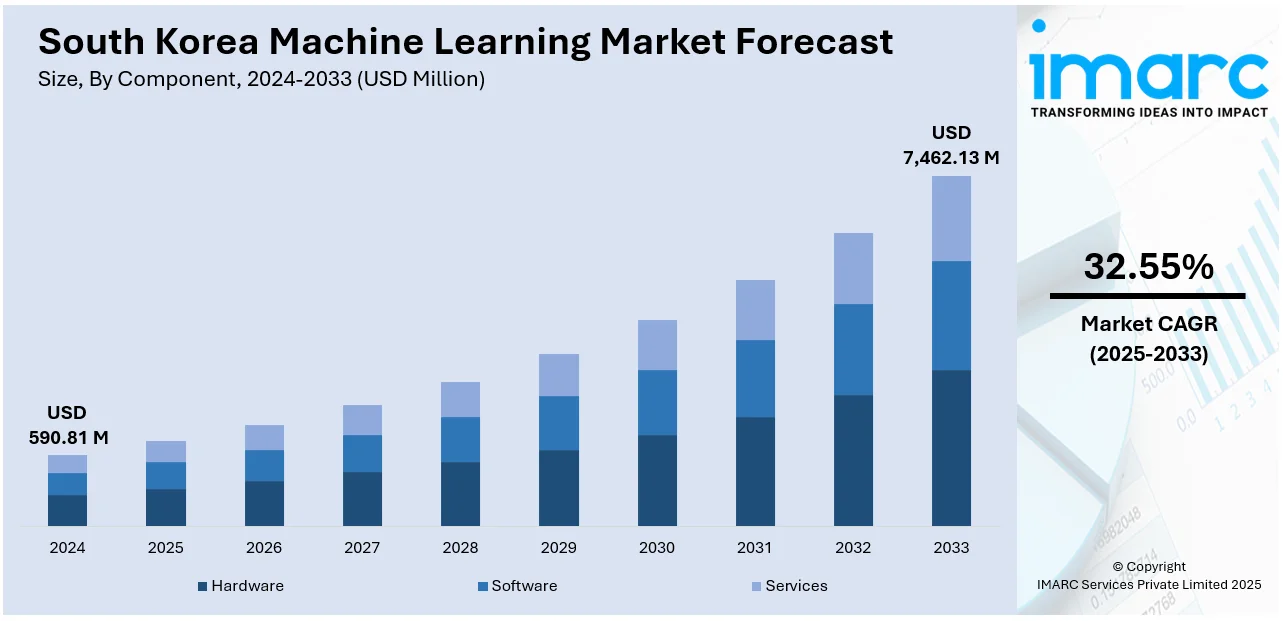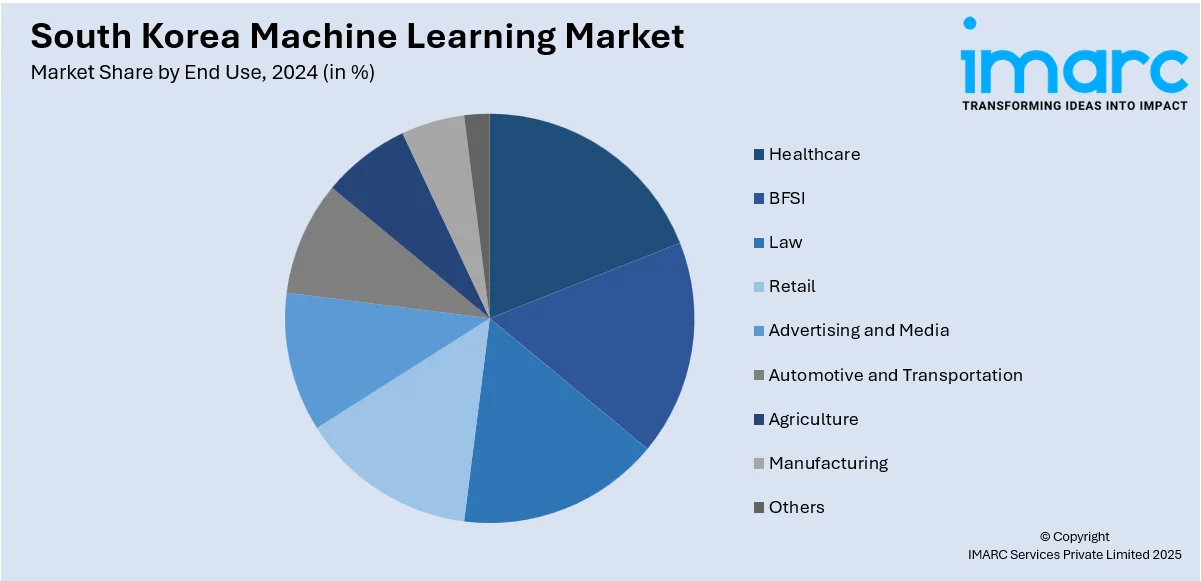
South Korea Machine Learning Market Size, Share, Trends and Forecast by Component, Deployment, Enterprise Size, End Use, and Region, 2025-2033
South Korea Machine Learning Market Overview:
The South Korea machine learning market size reached USD 590.81 Million in 2024. The market is projected to reach USD 7,462.13 Million by 2033, exhibiting a growth rate (CAGR) of 32.55% during 2025-2033. The market is fueled by growing investments in artificial intelligence (AI) infrastructure, global adoption of Industry 4.0 technologies, and firm government support for digital transformation. Apart from this, growing emphasis on smart manufacturing, autonomous systems, and cognitive data analytics is propelling the use of machine learning across industries. In addition, the robust semiconductor ecosystem in the country and growing demand for predictive analytics tools are also augmenting the South Korea machine learning market share.
|
Report Attribute
|
Key Statistics
|
|---|---|
|
Base Year
|
2024 |
|
Forecast Years
|
2025-2033
|
|
Historical Years
|
2019-2024
|
| Market Size in 2024 | USD 590.81 Million |
| Market Forecast in 2033 | USD 7,462.13 Million |
| Market Growth Rate 2025-2033 | 32.55% |
South Korea Machine Learning Market Trends:
Integration of Machine Learning in Smart Manufacturing Ecosystems
South Korea's advanced manufacturing sector is undergoing a transformative shift with the integration of machine learning (ML) into smart factory operations. As per industry reports, leading electronics manufacturer Samsung Group generated revenues of approximately KRW 331 Trillion (around USD 237 Billion) in 2024, accounting for 13% of South Korea’s GDP. Similarly, Hyundai Motor Corp., a major global automotive brand, reported sales of KRW 279 Trillion (USD 200.88 Billion), contributing roughly 11% to the national GDP. These figures highlight the dominant role of the electronics and automotive sectors in the country’s economy. In line with this, both industries are increasingly adopting machine learning technologies to maintain competitiveness and drive operational efficiency. Besides, ML algorithms are deployed to streamline supply chain management, enable predictive maintenance, and enhance quality assurance processes. Furthermore, the South Korean government's Smart Factory Initiative, aimed at deploying tens of thousands of intelligent factories by the end of the decade, offers funding and technical assistance to small and medium enterprises (SMEs) for ML integration. Additionally, the proliferation of industrial IoT devices and high-speed 5G networks facilitates seamless data collection and real-time analytics, which are essential for effective ML implementation. Also, strategic partnerships between global AI firms and domestic manufacturers further bolster the adoption rate, with pilot programs increasingly becoming full-scale deployments in sectors such as semiconductors, shipbuilding, and precision engineering.

To get more information on this market, Request Sample
Expansion of AI Research and Education Infrastructure
South Korea is prioritizing the development of a robust AI research ecosystem to support long-term machine learning innovation. This trend is positively impacting the South Korea machine learning market growth. Moreover, major universities, including KAIST and POSTECH, are expanding specialized AI departments, offering graduate-level ML programs, and engaging in collaborative projects with the private sector. In addition, government funding initiatives are directing significant resources toward creating AI-focused research hubs and fostering public-private-academic partnerships. For instance, the National Assembly has sanctioned a supplementary budget of KRW 1.9067 Trillion (about USD 1.3728 Billion) for the artificial intelligence sector, an increase of KRW 61.8 Billion (about USD 44.496 Million) over the initial government proposal. This expanded funding will enable MSIT to accelerate strategic initiatives aimed at strengthening South Korea’s global AI leadership and positioning the nation among the top three AI powerhouses worldwide. These efforts are aimed at nurturing a domestic talent pool capable of advancing ML applications across verticals. In parallel, AI-specific accelerators and incubators have emerged, providing early-stage ML startups with access to mentorship, cloud credits, and high-performance computing infrastructure. Apart from this, South Korean tech conglomerates are investing heavily in in-house research and development (R&D) activities and sponsoring ML-focused academic research to maintain global competitiveness. The growth of an innovation-driven ecosystem backed by educational reform and national policy is accelerating the pace of ML development and commercialization within the country.
South Korea Machine Learning Market Segmentation:
IMARC Group provides an analysis of the key trends in each segment of the market, along with forecasts at the country and regional levels for 2025-2033. Our report has categorized the market based on component, deployment, enterprise size, and end use.
Component Insights:
- Hardware
- Software
- Services
The report has provided a detailed breakup and analysis of the market based on the component. This Includes hardware, software, and services.
Deployment Insights:
- Cloud-based
- On premises
A detailed breakup and analysis of the market based on the deployment have also been provided in the report. This includes cloud-based and on premises.
Enterprise Size Insights:
- Large Enterprises
- Small and Medium-sized Enterprises
The report has provided a detailed breakup and analysis of the market based on the enterprise size. This includes large enterprises and small and medium-sized enterprises.
End Use Insights:

- Healthcare
- BFSI
- Law
- Retail
- Advertising and Media
- Automotive and Transportation
- Agriculture
- Manufacturing
- Others
A detailed breakup and analysis of the market based on the end use have also been provided in the report. This includes healthcare, BFSI, law, retail, advertising and media, automotive and transportation, agriculture, manufacturing, and others.
Regional Insights:
- Seoul Capital Area
- Yeongnam (Southeastern Region)
- Honam (Southwestern Region)
- Hoseo (Central Region)
- Others
The report has also provided a comprehensive analysis of all the major regional markets, which include Seoul Capital Area, Yeongnam (Southeastern Region), Honam (Southwestern Region), Hoseo (Central Region), and others.
Competitive Landscape:
The market research report has also provided a comprehensive analysis of the competitive landscape. Competitive analysis such as market structure, key player positioning, top winning strategies, competitive dashboard, and company evaluation quadrant has been covered in the report. Also, detailed profiles of all major companies have been provided.
South Korea Machine Learning Market Report Coverage:
| Report Features | Details |
|---|---|
| Base Year of the Analysis | 2024 |
| Historical Period | 2019-2024 |
| Forecast Period | 2025-2033 |
| Units | Million USD |
| Scope of the Report |
Exploration of Historical Trends and Market Outlook, Industry Catalysts and Challenges, Segment-Wise Historical and Future Market Assessment:
|
| Components Covered | Hardware, Software, Services |
| Deployments Covered | Cloud-Based, On Premises |
| Enterprise Sizes Covered | Large Enterprises, Small and Medium-Sized Enterprises |
| End Uses Covered | Healthcare, BFSI, Law, Retail, Advertising and Media, Automotive and Transportation, Agriculture, Manufacturing, Others |
| Regions Covered | Seoul Capital Area, Yeongnam (Southeastern Region), Honam (Southwestern Region), Hoseo (Central Region), Others |
| Customization Scope | 10% Free Customization |
| Post-Sale Analyst Support | 10-12 Weeks |
| Delivery Format | PDF and Excel through Email (We can also provide the editable version of the report in PPT/Word format on special request) |
Key Questions Answered in This Report:
- How has the South Korea machine learning market performed so far and how will it perform in the coming years?
- What is the breakup of the South Korea machine learning market on the basis of component?
- What is the breakup of the South Korea machine learning market on the basis of deployment?
- What is the breakup of the South Korea machine learning market on the basis of enterprise size?
- What is the breakup of the South Korea machine learning market on the basis of end use?
- What is the breakup of the South Korea machine learning market on the basis of region?
- What are the various stages in the value chain of the South Korea machine learning market?
- What are the key driving factors and challenges in the South Korea machine learning market?
- What is the structure of the South Korea machine learning market and who are the key players?
- What is the degree of competition in the South Korea machine learning market?
Key Benefits for Stakeholders:
- IMARC’s industry report offers a comprehensive quantitative analysis of various market segments, historical and current market trends, market forecasts, and dynamics of the South Korea machine learning market from 2019-2033.
- The research report provides the latest information on the market drivers, challenges, and opportunities in the South Korea machine learning market.
- Porter's five forces analysis assist stakeholders in assessing the impact of new entrants, competitive rivalry, supplier power, buyer power, and the threat of substitution. It helps stakeholders to analyze the level of competition within the South Korea machine learning industry and its attractiveness.
- Competitive landscape allows stakeholders to understand their competitive environment and provides an insight into the current positions of key players in the market.
Need more help?
- Speak to our experienced analysts for insights on the current market scenarios.
- Include additional segments and countries to customize the report as per your requirement.
- Gain an unparalleled competitive advantage in your domain by understanding how to utilize the report and positively impacting your operations and revenue.
- For further assistance, please connect with our analysts.
 Request Customization
Request Customization
 Speak to an Analyst
Speak to an Analyst
 Request Brochure
Request Brochure
 Inquire Before Buying
Inquire Before Buying




.webp)




.webp)












